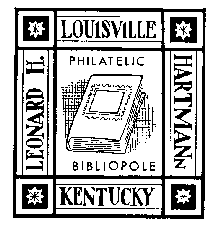
BRITISH COMMONWEALTH
POSTMARKS
by
Robert S. cragg
I think it must have been the late Lester Brookman who got me started on collecting postmarks. This is going on fifty years ago. I was looking at some Victorian Br. Guiana low values and there was "MAIL BOAT Ja 1, 1901", if I recollect the date correctly. I thought I wouldn't buy it because it was heavily struck and covered the whole stamp. Mr. Brookman convinced me it was a nice stamp, well worth the 5 or 10 cents and, of course, he was quite right. Now, after years of searching through dealer stocks, circuit books and auction catalogs, as well as many fine books and articles, I've put together some lists that might help you identify that troublesome partial postmark.
Attached are lists of villages and other offices where you may find a circular date stamp. Well, most are circular and almost all are dated. The lists are loosely arranged as follows:
- Name as it appears in an early cancel or in the majority of cancels. Many town names, especially in Africa and Asia, have a number of spellings in English. These are ignored. But, if the town name changed significantly, the newer name is in parentheses. Names often changed because of confusing same or similar names in the same colony. Also, independence led to de-Anglicization, especially if the town name included words such as "fort". If the town is a post office outside of the colony but administered by the colony, that is indicated.
- Next is the earliest date "known" of a dated cancel or, sometimes the date of opening. If not from literature, then from my collection. Sadly, most early dates from my collection are not that early
- Then there are letter or numeral killers used alone or in conjunction with a date stamp. Sometimes several different numbers were used, perhaps in different styles. This is a huge field, only touched on here.
- Lastly, the location of the village is given (or will later be given) by latitude and longitude. Sometimes this is only approximate, variables including inaccurate old maps, inaccurate new maps, moving of towns, confusion over similar town names, quirky software and my own clerical errors.
The lists are a place to get started. They are incomplete, the degree depending on what literature is available to the author. Focus is on villages with post offices around the turn of the century without attempting to include newer offices. The cut-off date for each colony varies, depending on manageability of the number of offices.
Many of the village marks are rare. Occasionally, only a single example is known. Some offices were open only a few months and have disappeared from modern maps. Especially, mining towns.
It is hoped that computer-generated maps can be made using the geographic coordinates, but that is another project for another day.
I would like to render the names searchable or at least sorted for right-reading.
Specialists in a given colony will be disappointed. Short-cuts abound. No attempt has been made to separate cancel types, establish earliest known dates by day and month or give closing dates.
Thanks to all the postal historians who have published their life's work ! You will want to buy their books.
More colonies will be added as I have the time.
Remember, lurking unappreciated or forgotten in the next old collection you see is a c.d.s. not on my lists ar anyone else's!
These lists will be expanded and perfected as time and information become available.
Remember, lurking unappreciated or forgotten in the next old collection you see is a c.d.s. that is not on my lists or anyone else's!
e-mail, Robert S. cragg
Reference Files
- Aden
- Antigua & Barbados
- Bahamas
- Bechuanaland & Protectorate
- Bermuda
- British Columbia
- British Guiana
- British Honduras
- Brunei
- British Cameroon
- Basutoland - Lesotho
- Burma
- Cape of Good Hope
- Cayman & Cook Islands
- Ceylon
- crete
- Cyprus
- Dominica
- Egypt & Used Abroad
- Falkland Islands
- Fijii
- Gilbert & Ellice Islands
- Gold Coast, Togoland
- Grenada
- Hong Kong
- Jamaica
- Jordan, Trans
- Kenya
- Lagos
- Malaya & States
- Malta & Gozo
- Mauritius
- Mesopotamia
- Montserrat
- Morocco Agencies
- Natal
- Nepal
- Newfoundland
- New Hebrides
- New Zealand
- Niger Coast, Oil Rivers
- Nigeria, Northern & Southern, TPO's
- North Borneo
- Orange River Colony, Orange Free State
- Palestine Towns
- Papua & New Guinea
- Persian Gulf
- Rhodesia, Northers & Southern
- St. Christopher, Nevis, Anguilla, St. Lucia & St. Vincent
- Samoa
- Sarawak
- Sierra Leone
- Solomon Islands
- Somaililand
- Sudan
- Swaziland
- Tanganyika
- Tasmania
- Tonga Island
- Transvaal
- Trinidad
- Uganda
- Virgin Islands
- Western Australia
- Zanzibar & Zululand
e-mail, Robert S. cragg ,
e-mail, Leonard
Return to PB Home Page
Hosted by Leonard H. Hartmann

